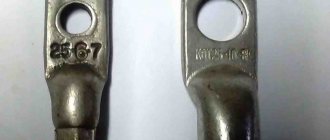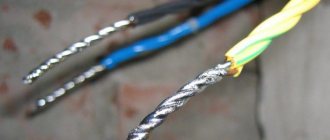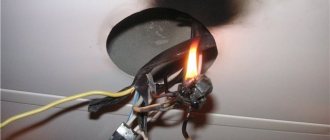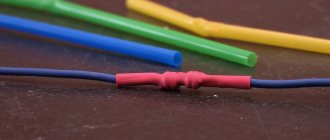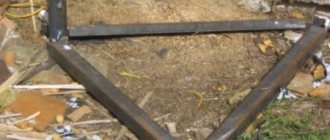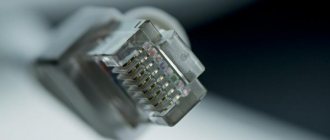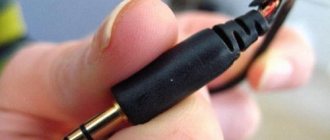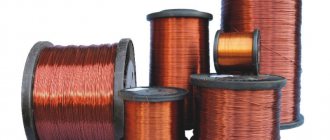Electrical wiring may consist of wires of different materials: aluminum or copper, and in certain situations it may be necessary to combine them. The connection principle is no different from connecting identical wires, as well as the method of connecting copper and aluminum wires, which can be done in any way. However, a direct connection can hardly be called a reliable and durable connection.
This is because aluminum combined with copper oxidizes, and corrosion occurs, which spoils the quality of the connection. Different wires will heat up more and melt under the influence of temperature, so long-term use of the direct method is considered unsafe for humans due to the risk of fire.
Features of connecting different wires
Most people who have at least some relation to electrical installation work are aware of the fact regarding the junction of copper and aluminum wires: it is not recommended to connect them. However, many people know about this, but they do it anyway: maybe they’ll hold out somehow.
As a result, it turns out that copper-aluminum twisting lasts a very, very short time. If the connection is placed outdoors or in a room with high humidity, the service life of such a pair is significantly reduced.
But situations in which it is necessary to connect copper and aluminum wires are far from uncommon. In particular, this phenomenon has practically become the rule when carrying out repair work in rooms with aluminum wiring.
In such cases, the solution to the problem will be specially made terminal blocks or bolt-type connections, through which contact between the copper and aluminum wires will be made. By using a clamped or bolted connection, direct contact between the two metals is eliminated. Let's consider the most popular options for such connectors, without delving into the design details.
Perhaps one of the earliest and most tested methods is to use a nut-type terminal connection. As you might guess, the reason for the name was the external similarity of the shape of the adapter to a nut.
The design of such a connection consists of three plates that clamp the wires together. The advantage of this type of connection is that there is no need to break the main line to install the outgoing wire. You just need to unscrew a couple of bolts, insert the desired wire between the plates, and then return the bolts to their place. The outgoing wire is allocated a place between the middle and third plate. Once it's in place, the connection is effectively complete.
In second place in popularity are spring-type express connection terminals. As the name suggests, their use provides maximum connection speed. Indeed, to make the connection, you only need to strip the ends of the copper and aluminum wires, and then insert them into the holes and fix them.
Inside such a terminal block there is a special lubricant that prevents the oxidation of the wires. It should be noted that such adapters are most suitable for lighting circuits or other areas with low load. For example, using it in a power circuit can cause the contact to overheat and break.
Terminal blocks have also found quite wide application. It looks like a strip on which the terminal blocks are located. To connect a wire to it, you need to strip the conductor and then fix it in the hole using a mounting screw. Accordingly, another wire is inserted into another hole.
Let’s assume an option in which wires made of copper and aluminum will be connected with a bolted connection. To do this, it is necessary to place a special anodized washer on the bolt between conductors of different metals, which prevents direct contact of the materials.
It should be borne in mind that installation work should be carried out by specialists of the appropriate profile. In the future, you should regularly check screw and bolt connections: for aluminum wires this is twice a year, for copper sections - once every 2 years.
What is the difficulty of connecting directly
The main problem when joining copper and aluminum is the development of electrocorrosion. If the environment is dry, then nothing happens when these metals combine directly. Moisture acts as an electrolyte, creating a “battery effect”. Metals, especially aluminum, are destroyed, and a break appears in the network, which leads to a short circuit or fire.
Why you can't connect copper and aluminum directly
To do this, you should strain your memory and remember the school course in chemistry and physics. To begin with, let's remember what a galvanic cell is. Simply put, a galvanic cell is a simple battery that generates electric current. The principle of its appearance is based on the interaction of two metals in the electrolyte. So, the twist between the copper and aluminum wire will be the same battery.
Galvanic currents quickly destroy the material. True, in dry air their appearance is excluded. And if you twist it to the socket, it will not fall apart in a few hours. However, later troubles with such wiring are guaranteed.
Over time, the materials from which the wires are made deteriorate, and along with this, the resistance constantly increases. If a powerful current consumer is connected to the outlet, the twist will begin to heat up.
Regular use of such an outlet increases the risk of fire. Therefore, connecting an aluminum conductor to a copper conductor is strictly prohibited. However, emergency situations arise when making such a connection is simply necessary.
Some tips for using Wago
If you are going to use such terminal blocks in lighting networks or in any other networks with a current limit of up to 10 A, then use Wago clamps safely, you don’t need to know any nuances or subtleties here.
When using terminal blocks in a network with a load of 10 to 20 A, the cleanliness of the conductor surface plays an important role. In addition, a circuit breaker must be installed in the circuit (10, 13, 16 or 20 A).
For loads above 25 A, it is better to stop using Wago terminal clamps and use soldering, welding or crimping wires.
You can independently increase the reliability of the connecting clamp, for example Wago 733. If your load reaches the maximum value, then proceed as follows. Strip the cores of the connected wires by 20-30 mm and insert them as expected into the terminal block. Now, turning the clamp clockwise, twist the remaining exposed parts of the wires and insulate them. Rest assured, the reliability of such contact has increased several times.
How to connect copper and aluminum wires
It's no secret that it is not recommended to connect copper and aluminum wires. But many, even knowing this, still neglect it, hoping for the Russian “maybe it will pass.” As a result, such twisting of a copper-aluminum pair will not last long. And if the connection is located outdoors or in a room with high humidity, then the lifespan of such a pair is several times shorter.
But quite often situations arise when we need to connect copper and aluminum wiring. Often this situation arises when repairing electrical wiring in houses where aluminum wiring is installed.
Special terminal blocks and bolted connections will help us get out of this situation, through which we will connect copper and aluminum wires. By using clamp and bolt connections, we do not allow direct contact between the copper-aluminum pair.
Without going too much into the design features of terminal clamps, we will consider the most used of them. One of the old and proven methods of connecting wires is nut-type terminal connections. They got their name because of their external resemblance to nuts.
Connections of this type consist of three plates, between which the wires are actually clamped. One of the advantages of this type of connection is that there is no need to break the main line to connect the outgoing wire. Simply unscrew the 2 bolts, insert a wire between the two plates, and screw the bolts into place. The outgoing wire is inserted between the middle and remaining plates. That's it, the connection is ready.
The next most popular are connections of the WAGO type. These connecting terminals allow you to connect wires made of aluminum and copper. It is enough to simply strip the wires by 10-15 mm, insert them into the hole in the terminal block, and that’s it, the next connection is ready for use.
The inside of the terminal block is filled with a special lubricant that prevents the wires from oxidizing. We recommend using this type of connection in lighting circuits. We do not recommend using these connections in power circuits, since a large load can lead to heating of the springy contacts, and as a result, poor contact.
Another popular connection is terminal blocks. Externally, they look like a strip with terminal strips. It is enough to strip the end of the wire, insert it into one hole and tighten it with a screw. The stripped end of the second wire is inserted into the other hole. These terminal blocks also allow you to connect wires of different metals.
Bolted wire connections. This type of connection can also be used if you need to connect copper and aluminum wires. When installing the connection, it is necessary to install a metal anodized washer between the copper and aluminum wire.
All installation work must be carried out by a specialist. All screw and bolt connections must be checked: for aluminum wires - once every six months, for copper - once every two years is sufficient.
How to solder aluminum to copper? This is theoretically possible, but practically it makes no sense. Such soldering requires special fluxes, higher temperatures (there is a high risk of overheating the wires) and over time, electrochemical corrosion will develop at the junction.
Twist connection
Twisting used to be the most common option for connecting wires during installation. This is due to the simplicity of the action, which does not require high qualifications from the performer. However, when connecting wires made of dissimilar metals, this option is completely unacceptable!
When temperature fluctuations in the environment occur, a gap appears in the twist between the wires, due to which the contact resistance increases, the connection heats up, and the wires oxidize. As a result, the contact between the conductors is completely broken.
Naturally, such an event does not occur immediately, but if long-term reliable operation of the electrical network is required, then a twisted connection cannot be used; it should be replaced with another, more reliable one. A fairly reliable contact will be obtained if the copper conductor is first tinned with solder.
In this way, you can twist wires with different diameters, even when one has many cores and the other only one. If there are several cores, you must first coat them with solder, after which you will get one core.
The twist performed must contain at least three turns for thick wires, and at least five if the conductor diameter is up to 1 mm. Twisting must be done in such a way that the wires wrap around each other, and not one wire wraps around another.
Threaded connection
If you connect a copper and aluminum conductor with a screw and nuts, you will get the most reliable contact, capable of ensuring conductivity for the entire life of the electrical wiring. This connection is easy to disassemble and also allows for the installation of many conductors. Their number is limited only by the length of the screw.
Any combination of metals can be successfully secured with a threaded connection. The basic rule is to prevent direct contact between aluminum and copper, and to install spring washers under the nuts. To properly organize a threaded connection, it is necessary to expose the conductors to a length that is four times the diameter of the screw.
If there is oxide on the wires, they are cleaned to a shine and rings are formed into which a screw can be inserted.
- Then put it on the screw:
- spring washer;
- a simple washer;
- conductor ring;
- a simple washer;
- ring of the second conductor;
- a simple washer;
- nut.
By tightening the screw, tighten the entire package until the spring washer straightens. To connect thin conductors, it is enough to use an M4 screw. With stranded copper wire, it is better to coat the ring with solder first.
Wago clamp connection
One of the new products on the electrical market are terminal blocks (article “Terminal blocks for junction boxes”), equipped with a Wago clamp from a German manufacturer.
- They come in two versions:
- Disposable designs - the wire is inserted and after it cannot be removed.
- Reusable – there is a lever that allows insertion and removal of the conductor.
Spring blocks are convenient for connecting wires inside distribution boxes and connecting chandeliers. It is enough to insert the wire with force into the hole on the box so that it is fixed securely. The Wago connector is a modern device for reliable and quick connection of wires, but its use is more expensive than other options.
There is one unpleasant thing to consider about Wago pads. There are often fakes on sale that look very similar to the original, but are of much worse quality. Such clamps will not provide good contact, and sometimes it will not be possible to insert the wire into them. Therefore, you need to be very careful when purchasing.
Permanent connection
The permanent connection has all the advantages of the threaded method. Its only drawback is the impossibility of subsequent disassembly without destroying the riveted assembly, as well as the need to have a special tool. To connect conductors with rivets, they are prepared in the same way as for a threaded connection. The rings are made so that the rivet passes through them freely.
First, an aluminum conductor is put on the rivet, then a spring washer, then a copper wire, and finally a flat washer. The steel rod of the rivet is placed into the tool and squeezed until its handle clicks. The connection is ready. The reliability of the one-piece connection option is quite high.
In a similar way, aluminum wires damaged in the wall during repair are successfully spliced by organizing an additional copper insert. It is imperative to reliably insulate the exposed parts of the resulting connection.
How to make a twist correctly
As mentioned above, direct twisting of aluminum wires with copper wires is unacceptable. However, in a number of situations, there is no other way out due to the lack of special connecting devices at hand. This method also has a number of advantages:
- Does not require the use of special tools.
- Fast and convenient.
- Makes it possible to quickly connect wires at home.
Connecting aluminum wires to copper wires by twisting is allowed as a temporary measure until special clamping devices are purchased. For more or less long-term use of twisting, a number of mandatory conditions will need to be met:
- The connection is made by mutually twisting two stripped ends. Simple winding of one core around another, straight one is not allowed.
- The stripped end of the copper wire should be tinned to reduce the electrochemical potential. For this purpose, tin solder is used.
- After twisting, the exposed parts of the cores are covered with a moisture-repellent coating, for example, varnish or silicone paste.
- The number of turns of twist also matters - the thinner the cores being connected, the more there should be. So, for wiring d = 1 mm, the minimum number of turns should not be less than five.
- On top of the twist, for its reliable fixation, special plastic cone-shaped tips with a spring inside are put on.
Electrochemical corrosion
Any electrician will confirm that copper and aluminum cannot be connected together, and this statement will be correct. What happens when two such different conductors touch? As long as there is no moisture, the connection will be reliable. However, there is always water vapor in the air, which becomes the culprit when the contact is destroyed.
Each conductor has its own electrochemical potential. This property of materials is widely used; accumulators and batteries are created on its basis. However, when moisture penetrates between the metals, a galvanic cell is formed that is short-circuited.
The current flowing through it destroys one of the metals in the connection. The easiest way out is to coat the copper wire with solder made from a mixture of tin and lead, then you can safely allow it to come into contact with aluminum, using any connection option! Connecting copper wires to old aluminum wiring is not at all difficult. The main thing in this process is to strictly follow the technological requirements.
WAGO
WAGO clamps for joining aluminum and copper are very popular, as they are very convenient to use:
- Click the pressure plates to the side.
- Insert wires into holes.
- Place the plates in their places and clamp them.
WAGO terminals for connecting copper wire to aluminum are an excellent solution
But now WAGO is casting doubt on its reputation. According to numerous reviews, the spring contact weakens, which leads to burning of the terminal block and its rapid replacement.
How to properly connect copper and aluminum wire
You can connect copper and aluminum conductors using a screw, a nut and three washers, one of which is a spring one. Strip the connecting wires. Place a lock washer on the bolt, then a simple washer. Bend the aluminum core into a ring and put it on next. Throw on a simple washer. Place the copper wire bent into a ring. Now tighten the connection with the nut until the spring washer is completely straightened.
A more convenient way to connect cores made of different materials is with terminal blocks. This product has a plastic body, busbar and terminals. It is enough to strip the wire to a length of 5 mm, tuck it into the terminal and tighten the screw. Contact between two conductors is prevented by the design of the terminal block itself. The connection must be placed in a junction box.
The fastest and easiest way to connect wires is with Wago spring terminals. There are disposable and reusable products. As the name implies, the first ones can be used only once: insert the end stripped of insulation and you’re done. To change the network diagram, you will have to cut off the terminal strip and connect the wires with a different product. Reusable Vagos allow you to insert and remove wires multiple times.
We use modern pads with spring clamps
Not long ago, modified terminals equipped with spring clamps were introduced to the market of electrical equipment and components. Disposable (conductors are inserted without the possibility of their further removal) and reusable (equipped with a lever that allows you to remove and insert cables) terminals are available.
We use modern blocks with spring clamps wago terminal blocks
| Terminal blocks wago | Current (A) | Number of connections wired | Conductor cross-section/(mm²) | Availability of contact paste |
| 222-413 | 32 | 3 | 0,08-4,0 | without paste |
| 222-415 | 32 | 5 | 0,08-4,0 | without paste |
Disposable terminal blocks allow you to connect single-core conductors with a cross-section within the range of 1.5-2.5 mm2. According to the manufacturers, such terminals can be used to connect cables in systems with currents up to 24 A. However, professional electricians are skeptical about this statement and do not recommend applying loads higher than 10 A to the terminals.
We use modern pads with spring clamps
Reusable terminals are equipped with a special lever (usually painted orange) and allow you to connect cables with any number of cores. The permissible cross-section of the connected conductors is 0.08-4 mm2. Maximum current – 34A.
To make a connection using these terminals, do the following:
- remove 1 cm of insulation from the conductors;
- lift the terminal lever up;
- insert the wires into the terminal;
- lower the lever.
Terminals without levers simply snap into place.
They are designed for connecting any types of single-core wires, including copper and aluminum wires with a cross-section from 1.5 to 2.5 mm2
As a result, the cables will be securely fixed in the block. The costs of making such a connection will be more significant, but you will spend much less time on the work and save yourself from the need to use any additional tools.
In a flat-spring clamp, the wire with stripped insulation is simply inserted into the hole in the Wago terminal until it stops
Electrical connectors with flush contact
Terminals for connecting aluminum and copper wires
If anyone still believes that there is nothing better for connecting wires than stripping their ends with a knife, twisting them, and wrapping them with electrical tape, then he is behind the times. Today there are already a lot of alternative devices that greatly facilitate the process of connecting wires, and at the same time are quite reliable. The times of twisting will soon disappear into oblivion, because they are being replaced by a variety of terminals.
What are the benefits of terminals? How, for example, can an aluminum wire be connected to a copper wire so that the connection is reliable and durable? It is strictly forbidden to twist copper and aluminum, because then a galvanic couple is formed, and corrosion will simply destroy the connection, and no matter how much current passes through the twist, it will collapse sooner or later, and if the current is higher, the devices will be turned on and off more often, then The twisting resistance will increase faster, and over time the heating of the twisted area will become more and more.
In the end, this is fraught with fire, or, at best, with the smell of melted insulation. The terminals would have been saved in this situation, and things would not have come to the point of destroying the contact point.
The simplest solution is to install a polyethylene terminal block. Polyethylene terminal blocks are sold today in every electrical goods store and are not expensive. Inside the polyethylene frame there are several tubes (sleeves) made of brass located in a row, in which the ends of the connected wires are clamped with two screws. If desired, you can cut off as many tubes in polyethylene as you need and connect as many pairs of wires as you want.
However, not everything is so rosy, aluminum flows under screw pressure at room temperature, so periodically, once a year, the connection will need to be tightened. Otherwise, when it comes to connecting copper conductors, everything will be fine.
If you do not promptly tighten the aluminum wire that is loose in the terminal block, then the end of the wire that has lost its former contact will spark and heat up, and this can lead to a fire. You cannot clamp stranded wires into such a terminal block without auxiliary pin lugs, which we will discuss later.
If you simply clamp a stranded wire into such a terminal block, then the pressure of the screw on the thin wires, combined with rotation and an uneven surface, will lead to the fact that some of the wires will become unusable, and this threatens overheating. If the stranded wire fits tightly along the diameter of the sleeve, this is the most acceptable connection option, because there is less risk of breaking the connection.
As a result, we can conclude that polyethylene terminal blocks are good for single-core, and only for copper wires. If you need to clamp a stranded one, you will have to wear an auxiliary tip, which will be discussed later.
The next option for convenient connection terminals is terminals on plastic blocks. Such terminal blocks are also equipped with transparent covers that can be removed if desired. Fastening is very simple: the stripped end of the wire is inserted between the pressure and contact plates, and pressed with a screw.
What are the advantages of such terminal blocks? Firstly, unlike polyethylene terminal blocks, plastic terminal blocks have an even steel clamp; there is no direct pressure of the screw on the cores. The clamping part has a recess for the wire. As a result, these terminal blocks are suitable for connecting groups of both single-core and stranded wires. Why groups? Because this terminal strip cannot be cut like a polyethylene one.
Next are self-clamping terminals (so-called wire connectors), an example of which is the 773 series from WAGO. These are express terminals for quick, one-time wiring installation. The wire is pushed all the way inside the hole, and there it is automatically fixed there by a pressure plate, pressing the wires against a special tinned busbar. The clamping force is maintained at all times due to the material of the clamping plate.
These express terminals are disposable, but in principle you can pull out the wire by gently rotating it as you pull it out. But if you pull out the wire, then it is better to make the next connection in a new clamp, fortunately, they are not expensive, 10-20 times cheaper than terminal blocks.
The internal copper plate is tinning, and allows you to fix either aluminum or copper wires. The pressing force is maintained continuously, and the wire does not have to be pressed once a year, as happens with terminal blocks.
Inside there is also a lubricant based on quartz sand with technical petroleum jelly, for an abrasive action that eliminates the oxide film on the surface of the wire, preventing, thanks to the petroleum jelly, its reappearance. These express terminals are available in transparent and opaque types. In any case, plastic does not support combustion.
WAGO branded express clamps are suitable for connections with an expected current of up to 25 A. Terminals from other manufacturers may suffer from heat, for example, the clamping force of spring contacts will weaken, so use only branded, well-proven terminals.
The 222 series from WAGO is suitable as reusable terminals. These are terminal blocks with lever clamps. Various types of wires can also be clamped here. The fastening process is simple: lift the lever, insert the end of the clamped wire, press the lever - fixation occurs.
This clip is reusable. When you lift the lever, the fixation is removed, you can pull out one wire and insert another. This terminal type is ideal for reconfiguring groups of conductors over and over again. Withstands currents up to 32 amperes without overheating. The design of the clamp is a bit similar to a disposable express clamp, the difference, again, is the ability to repeatedly switch the connected conductors.
Next, we will consider Scotch-lock type couplings. These are disposable couplings for wires designed for low currents. Using tape locks, you can connect telephone wires, low-power LED lamps, etc. The essence of this fastener is a mortise contact.
Several wires, directly in insulation, are inserted into the coupling, then crimped using pliers. Structured cabling installers love duct tape. Scotch locks allow you to connect wires without having to strip them. The plate with cutting contacts simply cuts into the insulation and comes into contact with the conductor, with the core.
Scotch locks come in two and three cores. The peculiarity of such terminals is that they are cheap, waterproof, universal, and do not require stripping the ends, but are crimped with simple pliers. There is a hydrophobic gel inside the coupling to protect the contacts from moisture and corrosion. If it is necessary to replace the connection, the adhesive tape is simply cut out along with the pieces of wires, and a new one is installed.
When you need to connect several wires into one powerful unit, for example, simply to combine them, or to lay them on a terminal block, sleeves are used. The sleeves are most often used as universal ones; these are usually tinned copper sleeves in the form of tubes, or in the form of flat tips with a mounting hole.
The wires are inserted into the sleeve and crimped with a special tool - a crimper. A crimper is a crimping pliers. The great advantage of the sleeves is that such crimping does not create increased resistance at the connection point. Sleeves in the form of a flat tip with a hole are convenient when you need to secure a wire or bundle of wires to the housing with a screw. Simply select a sleeve of the appropriate diameter, crimp it, and attach the tip where needed.
To connect stranded wires, to combine single-core wires with stranded wires, or simply to fix them in terminal blocks, pin sleeve lugs are used. The stranded wire is conveniently inserted into the lug, the lug together with the wire is crimped, after which the stranded wire can be fixed in any terminal block, even a polyethylene one, without fear that the connection will be broken.
The decisive thing here is the correct choice of the diameter of the tip; it must correspond to the total diameter of the cores being crimped, combined into a bundle, so that the wires do not jump out later. To crimp the pin terminals, you can use pliers or use a screwdriver and a hammer.
We connect the wires by twisting
Twist
Most often, ordinary twisting is used to connect wires. This is a simple method that does not require the use of additional devices. At the same time, twisting is the least reliable option for connecting conductors, especially if they are made of different materials.
Every metal has a tendency to change its size somewhat with temperature changes. The thermal expansion rate varies for different metals. Due to this property of materials, a gap may appear in the connection when the temperature changes. It will lead to an increase in contact resistance, as a result of which heat will begin to be generated, the cables will oxidize and the connection will be broken.
Bandage twist
Of course, this takes many years, but if your plans include setting up a durable and high-quality network, it is better to abandon the twisted connection in favor of a more reliable option.
The method is suitable for connecting cables of different diameters. It is permissible to twist single-core and stranded wires, but in such a situation, a conductor with several cores must first be tinned with solder so that it turns into a single-core wire.
Connecting wires by welding
The cables are twisted, after which the connection is sealed. A protective varnish with water-resistant properties is well suited for sealing. To ensure the highest quality connection, it is recommended to tin the copper cable with solder before starting work.
Connecting wires by twisting
The number of turns in the connection is selected in accordance with the diameter of the cable. If the diameter of the conductor does not exceed 1 mm, we make at least 5 turns. When twisting thicker wires, make at least 3 turns.
Connection recommendations
Why is it strictly forbidden to connect copper and aluminum wires directly? Aluminum is a highly oxidizable metal. This is the process of formation of an oxide film on its surface, which has a very high resistance, which naturally cannot but affect the conductivity of such a connection. Copper wires are less susceptible to oxidation, or rather, the oxide film on them has much less resistance than the oxide film on aluminum wires, so this affects the current conductivity very little.
Therefore, when connecting copper and aluminum wires, electrical contact actually occurs through oxide films of copper and aluminum, which have different electrochemical properties, which can significantly impede current conduction at this junction. On the street, under the influence of precipitation and the passage of electric current through the connection, the process of electrolysis occurs. The result is the formation of shells at the junction, heating and sparking of the contacts - an increased fire hazard of the joint.
- There are the following options for connecting copper and aluminum wires:
- Connections of copper and aluminum wires outdoors or indoors are allowed only with the use of special adapters - terminal blocks. A good solution for outdoor connections would be to use branch clamps for SIPs (“punctures”) with a paste that protects the surface of the wires from oxidation.
- A good option is branch clamps (“nuts”) - the wires in them are connected through an intermediate plate inside, i.e. direct contact of copper with aluminum is excluded.
- Indoors, it is advisable to use Wago self-clamping terminal blocks with a paste that prevents the oxidation of aluminum wires. This is a quick way to connect copper and aluminum wires and does not require additional insulation. Due to their small size, self-clamping, screw or spring terminal blocks are very convenient for connecting wires in junction boxes.
- Finally, if you don’t have a terminal block or “nut” at hand, there are different situations, it is much safer, instead of the usual twisting of copper and aluminum wires, to tighten them with a bolt and nut, placing a washer between them, which will prevent direct contact of copper and aluminum. In terms of contact reliability, such a connection will be inferior to manufactured terminal blocks or “nuts”, except that it is bulkier - it is more difficult to place it in a junction box. When using this method, it is also worth noting the need for good insulation of the connection.
Using twists or terminal blocks
When connecting conductors, many important factors must be taken into account: the material of the current-carrying cores of the switched wires, their electrochemical compatibility or incompatibility (in particular, copper and aluminum), wire cross-section, twist length, network load, etc.
However, the regulatory documents regulating the rules for performing electrical installation work, in particular the PUE (Electrical Installation Rules), clearly state the prohibition on connecting wires using the twisting method: PUE: clause 2.1.21. Connection, branching and terminating of wires and cables must be carried out using crimping, welding, soldering or clamping (screw, bolt, etc.) in accordance with current instructions.
As you can see, the PUE allows only 4 types of wire connections, and twisting is not among them (except for cases when the twisting is preliminary, for example, before soldering or welding). Therefore, endless debates and discussions about the advantages or disadvantages of twists lose all meaning, because not a single fire inspector will approve an electrical installation if its wires are switched using twists.
Soldering or welding significantly increases installation time; this procedure is much longer than using terminal blocks - you need to remove the insulation from the wires, tin the wires, if it is soldering, connect the welder, then insulate all the wires. If it is necessary to reconnect the wires (for example, add a wire), there are also difficulties - removing the insulation, soldering (cooking) again. With terminal blocks everything is much simpler, but better contact is achieved using welding or soldering.
There are different types of terminal blocks suitable for connecting electrical wires in an apartment or house.
- Here are the main and most common among them:
- Self-clamping terminal blocks can have from 2 to 8 places for wires with a minimum cross-section of 0.75 mm2 and a maximum of 2.5 mm2. Capable of withstanding loads up to 4-5 kW (24 A). Such terminal blocks are very convenient to install, greatly reducing installation time - there is no need to twist and then insulate the wires. But, they take up more space in solder boxes, unlike twists, which can be given any shape, laid out, bent in any way.
- Connecting screw terminal blocks are designed to connect wires to each other. Typically used for switching wires in distribution boxes. Material: polyethylene, polyamide, polycarbonate, polypropylene. It is better not to use such terminal blocks for aluminum wires - in screw terminal blocks they are severely deformed and can be broken.
Insulating connecting clamps (PIC) are used to connect single-wire cores of wires with a total maximum cross-section of up to 20 mm2 and a minimum cross-section of 2.5 mm2. They have an insulated casing made of polyamide, nylon or fire-resistant PVC, so that the wires do not require further insulation, into which an anodized conical spring is pressed.
When connecting the wires, the insulation is removed from them (10-15 mm), collected into one bundle and the PPE is screwed onto them (clockwise) until it stops. PPE caps are very convenient and easy to install, but they are much inferior to terminal blocks in the quality of twisting, so it is still better to give preference to terminal blocks.
Device and technical parameters
The terminal is a flat-spring action clamp, which with its entire area exerts pressure on the surface of the wire and does not cause damage. The Vago connecting clamp provides excellent contact due to the highly concentrated clamping force, which creates low contact resistance over the entire contact surface.
To manufacture the current-carrying rail, electrolytic spring-hard copper with a soft tinned surface is used. The surface coating is made with a tin-lead alloy (60% tin and 40% lead), which protects against corrosion for a long time.
For the manufacture of clamping springs, high-quality austenitic chromium-nickel steel is used; it has a very high tensile strength.
Polyamide is used as insulating materials. It has a number of advantages:
- absolutely neutral to corrosive processes;
- it has the property of self-extinguishing;
- is difficult to ignite.
For Vago terminal blocks during operation, the lower temperature limit is -35 °C. The upper temperature indicator for short-term exposure is from 170 °C to 200 °C (depending on the type of terminal block).
Connectors of this type are used not only in household electrical networks, but also in industrial production. Therefore, their technical characteristics have a very wide range of values:
- cross-section of connected wire cores – 0.08-95 mm2;
- operating voltage – 100-1000 V;
- rated throughput current – 6-323 A.
Wago terminals | Reviews of twisting copper with aluminum
In this article, I will tell you the real experience of using Wago terminal blocks in everyday life , more precisely in the repair activities of our workshop. In addition to repairing lighting devices and sound amplifiers , we also repair power electronics , such as welding inverters and car starter-chargers. It would seem that there is no need to continue further, the Wago terminals are not designed for installation in a junction box where currents exceed 20-30 Amperes, and this is the current consumed by the welding inverter, but do not rush to break off. Our electrical distribution box (in other words, wiring) assembled on Wago terminals did not smoke and burn because of this.

